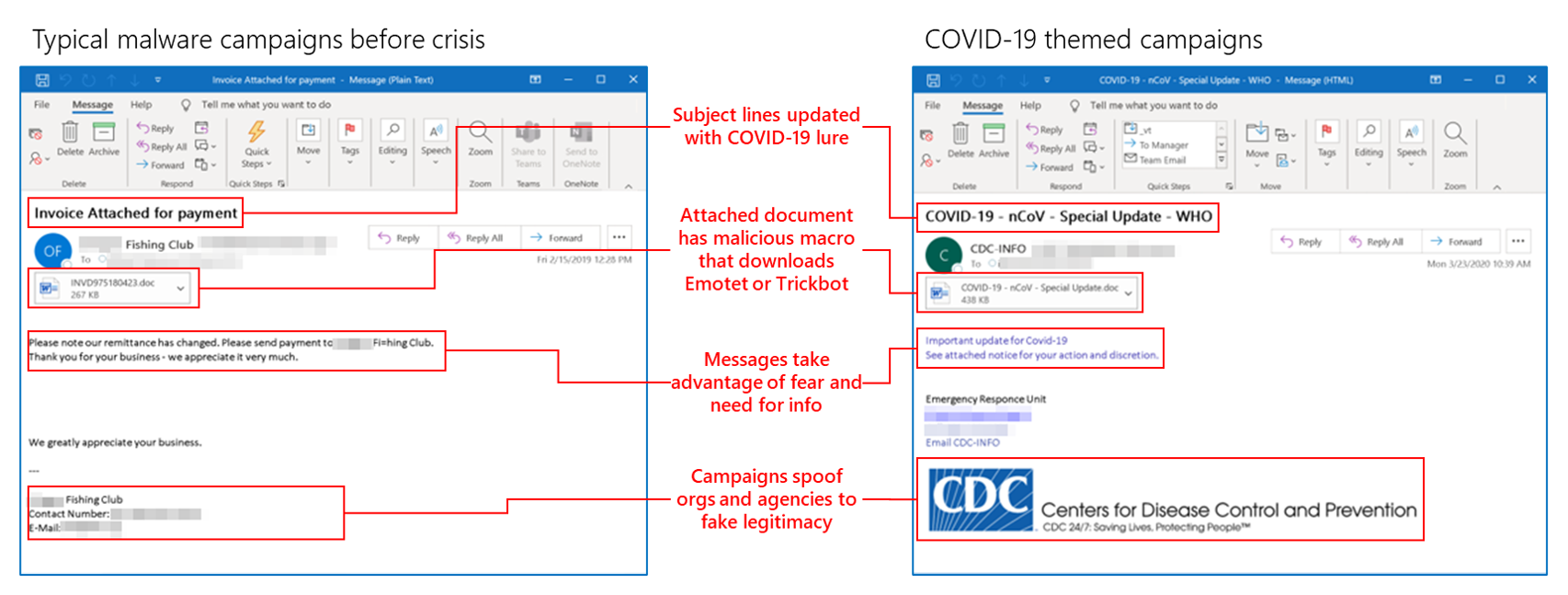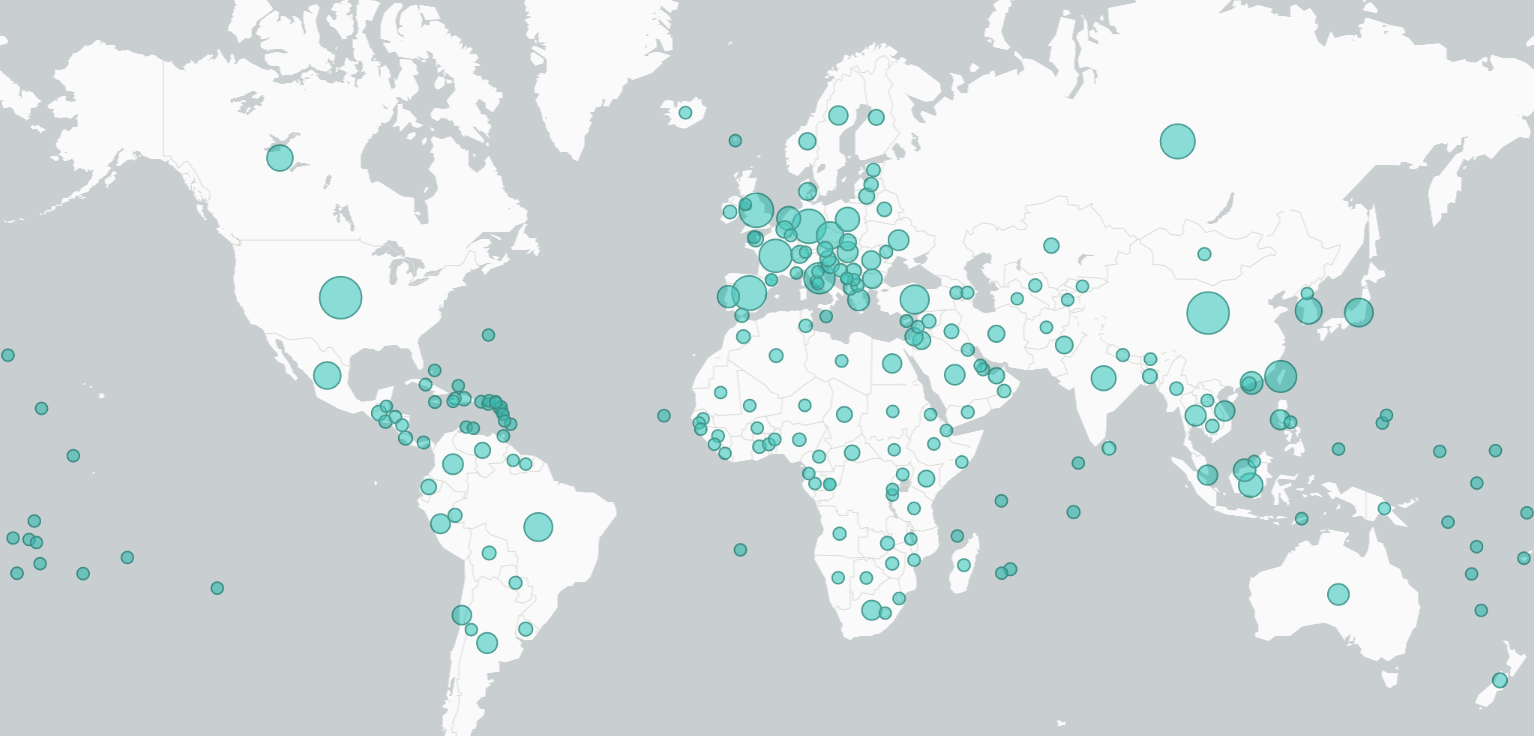Ready or not, much of the world was thrust into working from home, which means more people and devices are now accessing sensitive corporate data across home networks. Defenders are working round the clock to secure endpoints and ensure the fidelity of not only those endpoints, but also identities, email, and applications, as people are using whatever device they need to get work done. This isn’t something anyone, including our security professionals, were given time to prepare for, yet many customers have been thrust into a new environment and challenged to respond quickly. Microsoft is here to help lighten the load on defenders, offer guidance on what to prioritize to keep your workforce secure, and share resources about the built-in protections of our products.
Attackers are capitalizing on fear. We’re watching them. We’re pushing back.
Our inboxes, mobile alerts, TVs, and news updates are all COVID-19, all the time. It’s overwhelming and attackers know it. They know many are clicking without looking because stress levels are high and they’re taking advantage of that. That’s why we’re seeing an increase in the success of phishing and social engineering attacks. Attackers don’t suddenly have more resources they’re diverting towards tricking users; instead they’re pivoting their existing infrastructure, like ransomware, phishing, and other malware delivery tools, to include COVID-19 keywords that get us to click. Once we click, they can infiltrate our inboxes, steal our credentials, share more malicious links with coworkers across collaboration tools, and lie in wait to steal information that will give them the biggest payout. This is where intelligent solutions that can monitor for malicious activity across – that’s the key word – emails, identities, endpoints, and applications with built-in automation to proactively protect, detect, respond to, and prevent these types of attacks from being successful will help us fight this battle against opportunistic attackers.
Our threat intelligence teams at Microsoft are actively monitoring and responding to this shift in focus. Our data shows that these COVID-19 themed threats are retreads of existing attacks that have been slightly altered to tie to this pandemic. This means we’re seeing a changing of lures, not a surge in attacks. Our intelligence shows that these attacks are settling into a rhythm that is the normal ebb and flow of the threat environment:
- Every country in the world has seen at least one COVID-19 themed attack (see map below). The volume of successful attacks in outbreak-hit countries is increasing, as fear and the desire for information grows. Our telemetry shows that China, the United States, and Russia have been hit the hardest.
- The trendy and pervasive Trickbot and Emotet malware families are very active and rebranding their lures to take advantage of the outbreak. We have observed 76 threat variants to date globally using COVID-19 themed lures (map below).
- Microsoft tracks thousands of email phishing campaigns that cover millions of malicious messages every week. Phishing campaigns are more than just one targeted email at one targeted user. They include potentially hundreds or thousands of malicious emails targeting hundreds or thousands of users, which is why they can be so effective. Of the millions of targeted messages we see each day, roughly 60,000 include COVID-19 related malicious attachments or malicious URLs.
- While that number sounds very large, it’s important to note that that is less than two percent of the total volume of threats we actively track and protect against daily, which reinforces that the overall volume of threats is not increasing but attackers are shifting their techniques to capitalize on fear. Attackers are impersonating established entities like the World Health Organization (WHO), Centers for Disease Control and Prevention (CDC), and the Department of Health to get into inboxes. Here’s an example of what just one of these malicious emails looks like now compared to before the COVID-19 crisis:

- In a single day, SmartScreen sees and processes more than 18,000 malicious COVID-19-themed URLs and IP addresses. This again shows us that attackers are getting more aggressive and agile in the delivery of their attacks – using the same delivery methods, but swapping out the malicious URLs on a more frequent basis in an effort to evade machine learning protections.
- Microsoft Office 365 Advanced Threat Protection prevented a big phishing campaign that used a fake Office 365 sign-in page to capture credentials. Roughly 2,300 unique HTML attachments posing as COVID-19 financial compensation information were caught in 24 hours in this one campaign. We expect to see more campaigns that utilize the economic fear from lost income, as governments widen the mandatory shutdown of their economies and stimulus funds begin to be issued in the U.S.
- Several advanced persistent threat and nation-state actors have been observed targeting healthcare organizations and using COVID-19-themed lures in their campaigns. We continue to identify, track, and build proactive protections against these threats in all of our security products. When customers are affected by these attacks, Microsoft notifies the customer directly to help speed up investigations. We also report malicious COVID-19-themed domains and URLs to the proper authorities so that they can be taken down, and where possible, the individuals behind them prosecuted.

Relative impact of COVID-19 themed attacks across the world by file count (as of April 7, 2020)
From endpoints and identities to the cloud, we have you covered
While phishing email is a common attack vector, it’s only one of the many points of entry for attackers. Defenders need a much broader view and solutions for remediation than visibility into just one entry method. An attacker’s primary goal is to gain entry and expand across domains so they can persist in an organization and lie in wait to steal or encrypt as much sensitive information as they can to reap the biggest payout. Defenders require visibility across each of these domains and automated correlation across emails, identities, endpoints, and cloud applications to see the full scope of compromise. Only with this view can defenders adequately remediate affected assets, apply Conditional Access, and prevent the same or similar attacks from being successful again.



